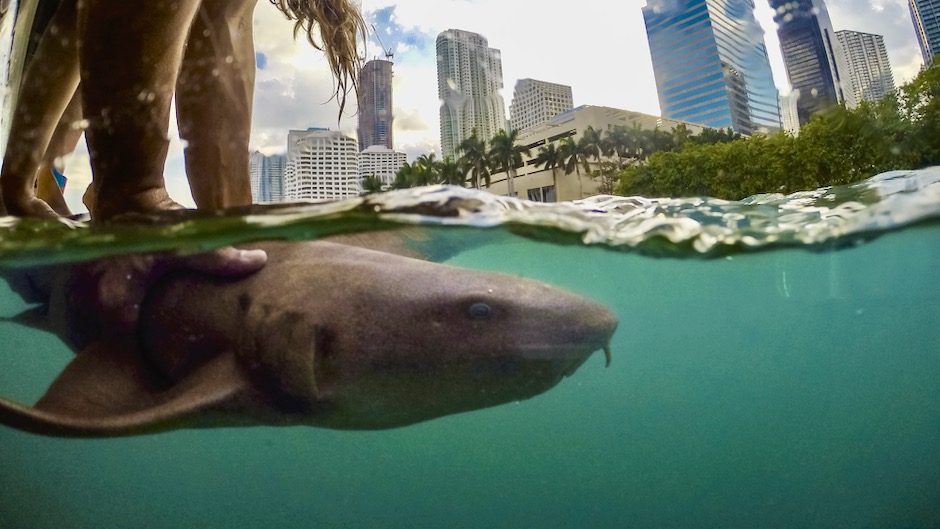Sharks may be closer to the city than you think, new study finds.
Article originally appeared on UM News and Events. Original article can be viewed here. Published scientific article can be viewed here.
Unlike big land predators, the ocean’s top predators don’t avoid urban areas
The world’s coastlines are rapidly urbanizing, but how this increased human presence may impact species living in the ocean is not fully understood. In a new study led by scientists at the University of Miami (UM) Rosenstiel School of Marine and Atmospheric Science, researchers tracked the movements of three shark species, bull, nurse and great hammerhead, in relation to the city of Miami. Given the chemical, light, and noise pollution emanating from the coastal metropolis, researchers expected sharks to avoid areas close to the city, but that’s not what they found.
Some animals, like pigeons and racoons, thrive in cities. These species, known as “urban exploiters,” often become dependent on human garbage for food. Other animals, known as “urban adapters,” may show some use of urbanized areas, but still largely rely on natural areas. On the other hand, some species such as land predators such as wolves are very sensitive to human disturbance. These “urban avoiders” avoid big cities.
“Few studies have investigated the movements of ocean predators in relation to urbanization, but since other studies have shown that land predators are urban avoiders, we expected sharks to be too,” said Neil Hammerschlag, director of the UM Shark Research and Conservation Program and lead author of the study. “We were surprised to find that the sharks we tracked spent so much time near the lights and sounds of the busy city, often close to shore, no matter the time of day.” The researchers concluded that the behaviors of the tracked sharks resembled that of “urban adapters”. The study speculates sharks could be attracted to shore from land-based activities, such as the discarding of fish carcasses.
The relatively high use of urban-impacted areas by the tracked sharks may have consequences for both sharks and humans. “By spending so much time close to shore, sharks are at risk of exposure to toxic pollutants as well as fishing, which could impact their health and survival,” said Hammerschlag. While shark bites on humans are rare, the study also pinpoints areas close to shore that could be avoided by human water users to reduce probability of a negative shark encounter, promoting human-shark coexistence.
The study, titled “Urban Sharks: Residency patterns of marine top predators in relation to a coastal metropolis”was published June 16, 2022 in the journal Marine Ecology Progress Series.
The study’s authors include: Neil Hammerschlag, Mitchell Rider from the UM Rosenstiel School, and Robbie Roemer, from Ocearch; Austin J. Gallagher from Beneath the Waves; and Lee Gutowsky from Trent University.
This research was funded through support from the Ocean Tracking Network, the Disney Conservation Fund, the Save Our Seas Foundation, the National Oceanic and Atmospheric Administration (NOAA) Southeast Fisheries Science Center, the Batchelor Foundation, the Herbert W. Hoover Foundation, Ruta Maya Coffee, the International Seakeepers Society, and through a grant ‘Implementing a Marine Biodiversity Observation Network (MBON) in South Florida to Advance Ecosystem-Based Management’ funded under the National Oceanographic Partnership Program (NOPP, RFP ONR BAA #N00014-18-S-B007, in partnership with NOAA, BOEM, and NASA) and the US Integrated Ocean Observing System (IOOS) Program Office.

